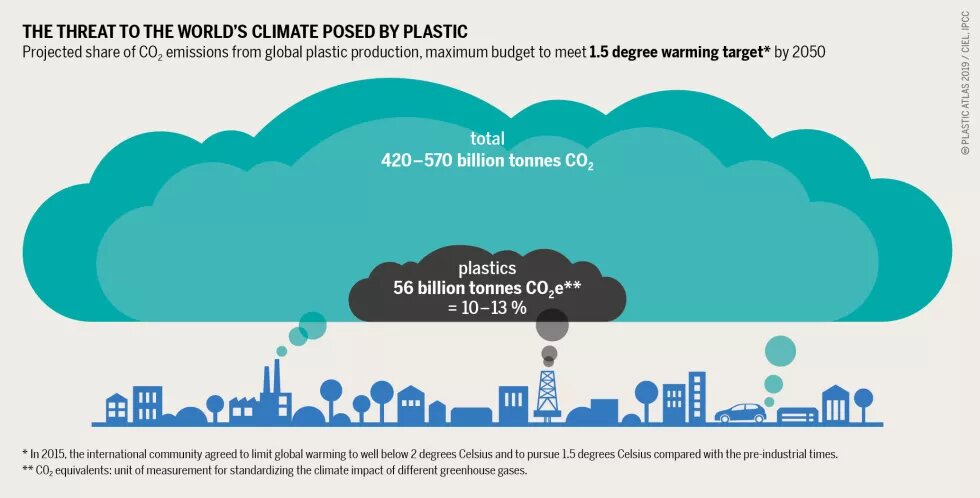
From manufacture to disposal by incineration, plastics pump huge amounts of greenhouse gases into the atmosphere.

Making, using, and disposing of plastics all have serious effects on marine ecosystems, coastal environments, and human health. While the impact on climate is less well-known, it is just as significant.
In the 2015 Paris Climate Agreement, over 190 nations committed at that time to limit global warming to well below two degrees Celsius , and to pursue measures to keep the overall rise in temperature below 1.5 degrees.
In 2018, the Intergovernmental Panel on Climate Change (IPCC) concluded that to keep warming below the 1.5-degree limit, global greenhouse gas emissions must be cut by 45 percent by 2030 and zero net emissions reached no later than 2050.
While climate policy is largely focused on the transition to renewable energy and cleaner transport, industry is also important. According to World Resource Institute’s 2016 data, energy consumption is by far the biggest source of human-caused greenhouse gas emissions, responsible for 73 percent worldwide. The other top sectors are agriculture (12 percent); land use, land-use change, and forestry, such as deforestation (6.5 percent); industrial processes of chemicals, cement, and more (5.6 percent); and waste, including landfills and waste water (3.2 percent).The production of plastics is one of the largest contributors to these emissions, a contribution that is rapidly increasing.
Plastics, along with many fertilisers, pesticides, and synthetic fibres, are petrochemicals, derived from mineral oil and natural gas. More than 99 percent of plastics come from such fossil-fuel feedstocks. Meanwhile, petrochemicals are the fastest-growing form of oil consumption globally. The International Energy Agency forecasts they will account for half of the extra demand for oil by 2050.
As plastic production grows, it will lock in new fossil-fuel infrastructure and increase emissions that arise from the exploration, extraction, transport, and refining of oil, gas, and coal. Global production of plastics increased from two million tonnes in 1950 to almost 370 million tonnes in 2019, with production and use of plastics nearly doubling in the past 20 years. They are expected to double again over the next 20 years, and quadruple by the early 2050s.
Carbon dioxide, methane, and an array of other greenhouse gases are released at each stage of the plastics life cycle , from the extraction and refining of fossil fuels and the energy-intensive processes that produce plastic resins to disposal, incineration, and potential release of waste plastics into the environment.
This has major implications for efforts to meet global climate goals. To avoid overshooting the 1.5 degree target of the 2015 Paris Climate Agreement, the IPCC recommended that the total amount of carbon dioxide that the world can still emit must stay below the remaining (and quickly declining) budget of 420 to 570 billion tonnes.
However, 2019 estimates by the non-profit Center for International Environmental Law, a public interest environmental law firm, suggest that at current and projected rates of growth, production of plastics alone could generate 53.5 billion tonnes of carbon dioxide emissions by 2050. The addition of incineration of waste plastics pushes this total up to nearly 56 billion tonnes.
In other words, plastics could consume between 10 and 13 percent of the earth’s remaining carbon budget for staying below a global temperature rise of 1.5 degrees.
Even assuming plastic production grows much more slowly after 2050, and incineration does not grow at all, emissions from plastic production and incineration could total nearly 260 billion tonnes of CO2 equivalent by the end of the century, potentially consuming over half the available carbon budget.
And these figures may still underestimate plastics’ total climate impact, as little is known about certain aspects of the extraction, transport, and refining of fossil feedstocks for plastics in terms of their effect on emissions and other climate issues.
Moreover, emissions from plastics do not end when they are thrown away. Waste-to-energy projects that incinerate plastics are increasingly being proposed as a solution to plastic pollution. In Southeast Asia alone, the waste-to-energy market is projected to grow 15.5 percent and reach a value of US$13.66 billion by 2023.
Banks, financial sponsors, and private equity firms are expected to further tap into waste-to-energy ventures. In 2021, there were 10 waste-to-energy plants across the Association of Southeast Asian Nations member states. However, China and Japan remain the major regional players in the sector.
Given that incineration emits large amounts of greenhouse gases, the widespread deployment of waste-to-energy could lead to a large rise in emissions while simultaneously increasing toxic exposure for communities near and far from incinerators.
As such, transferring the threat of plastics from the oceans to the air while compounding plastics’ climate impacts is the very definition of a false solution.
The effect on emissions may also be indirect. Growing levels of microplastic debris in the oceans may interfere with the biological processes through which plankton capture carbon dioxide at the sea surface and sequester carbon in the deep oceans.
This biological carbon pump is part of the oceanic carbon sink, contributing to the earth’s climate balance. The mechanisms and extent to which microplastics may be interfering with that balance are of great importance, but remain poorly understood. More research on these mechanisms and interactions is required.